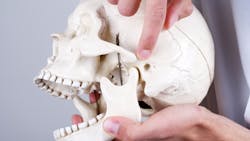Experiencing TMD? Why it’s important to seek a diagnosis
As dental team members returned to clinical practice during the pandemic, with all the new protocols and PPE including N95 respirators, many began to experience temporomandibular joint (TMJ) disorder (TMD) symptoms for the first time or saw an increase in previous symptoms. In September 2020, I wrote an article addressing this development, “The complexities of temporomandibular disorder.”
The survey results
As a result of seeing and hearing from hygienists about TMD following the article, I decided to perform an informal survey to determine what symptoms and treatments dental professionals have been experiencing. The survey was conducted from mid-October to mid-November 2020.
The survey consisted of ten questions including the questions below, along with the respondent’s email address and interest in being contacted about the survey:
- Have you returned to clinical dental hygiene following the COVID shutdown? Were you working full- or part-time prior to the shutdown? What is your current status, full- or part-time?
- What TMD symptoms are you currently experiencing?
- Did you have any TMD symptoms prior to your return?
- If yes, what were they? What was the prior diagnosis?
- What has helped your current TMD symptoms?
- What has made your current TMD symptoms worse?
- Have you sought treatment for your current symptoms?
- If yes, what was the diagnosis and recommended treatments?
Most respondents did not leave their email address or want to be contacted for further questions about the survey. I reached out to those who had requested being contacted.
Of the respondents, 66% had been working full-time prior to the pandemic, and have returned to work full-time after the shutdown, while 34% were employed part-time both before and after the shutdown. Only two respondents stated they are no longer practicing due to COVID-19 concerns, or non-COVID health-related issues. The percentages of people who had TMD symptoms prior to shutdown were split, with 35% having prior TMD symptoms and 65% not having any previous symptoms.
For those currently experiencing symptoms, the most common was headache. This corresponds to a larger research survey conducted by Anne Guignon, MPH, RDH, in June 2020 (personal communication), on the impact of PPE usage on health-care professionals, with 53.62% of her survey participants stating they were suffering from more headaches than ever while wearing PPE. Other symptoms noted in my informal study were:
- TMJ pain and popping on movement
- Tightness/pain in the lateral and medial pterygoid or masseter muscles
- Increased clenching and bruxing
- Occlusion feeling “off”
- Limited range of motion with an inability to open or close completely or to eat a sandwich
- Chipped posterior teeth and heavy wear facets
- Transient tooth sensitivity
The Guignon study likewise noted TMJ pain, clogged or ringing ears, and bite/occlusal changes.
How clinicians are coping
For those experiencing symptoms, wearing a splint during the day or nightguard at night, use of nonsteroidal anti-inflammatories (ibuprofen was the most commonly cited), muscle massage or fascial release, eating a soft diet, or using moist heat or ice have all reduced symptoms.
Other helpful remedies included chiropractic therapy, mediation, muscle relaxants, or Botox injections. Many respondents stated they felt the use of the N95 respirator had significantly increased their symptoms and reducing wear time decreased their issues. Having to maintain their airway by positioning the mandible forward while wearing the N95, along with the pressure associated with it, appeared to be the major causes of concern. The high stress levels of returning to clinical practice with all the additional protocols added to their distress. Being aware of mandibular position while wearing the N95 often helped along with taking frequent breaks.
As dentistry begins to understand the relationship between N95 usage and a number of related symptoms from headaches, dry mouth, tiredness, and shortness of breath, to acne, among others, other protective devices will be developed to reduce symptoms while protecting the dental professional and patient.
Several participants mentioned that with the added protocols and patients being away from care for extended periods, the hygiene appointment was more difficult, especially without the use of power scaling. In addition, patients seeing their hygienist, who may be the one of their few social interactions, want to spend more time talking than usual, again increasing the hygienist’s stress levels when there's inadequate time for treatment.
The importance of a diagnosis
Yet with all of the symptoms and stress, only 20% have sought treatment for TMD, with the treatment of choice as having a nightguard made or remade. No respondents mentioned a definitive TMD diagnosis!
TMD consists of a myriad of signs and symptoms, and one type of treatment may or may not alleviate the disorder. Understanding that TMD can either be related to a muscular problem, a structural joint problem, or a combination, the astute clinician will determine the appropriate therapy. Utilizing only a nightguard for treatment when a proper diagnosis has not been rendered is like putting a Band-Aid on a bleeding wound—it helps, but may not solve the problem.
Understanding the anatomy of the joint and musculature is an important consideration. Appropriate diagnostic tools such as MRI, CBCT/conventional CT, panoramic, cepholmetric imaging, bite analysis, doppler auscultation, or injections are invaluable in determining the appropriate course of treatment and the correct diagnosis.
Yet, it all begins with a through intra- and extraoral evaluation, examining opening, closing, lateral excursive range of motion while palpating the joint and muscles. Analyzing the patient’s posture is also important. For many who are experiencing TMD symptoms, both dental professionals and the lay public, the use of respirators/masks often results in trying to maintain the airway. When it becomes difficult to maintain normal airflow, the tendency is to reposition the mandible or the entire head forward. By moving the head forward, it becomes heavier off the spinal column and can lead to muscle pain. Muscle pain can result in headaches or neck/back pain.
Prolonged forward head posturing, along with other microtraumas, may cause the meniscus or disc within the joint to move out of position, creating a structural joint problem. Having a true TMD diagnosis is paramount to alleviating symptoms.
Often patients say “I have TMJ,” or I have TMD,” but that is not a diagnosis. It is only a description, and as dental professionals experiencing TMD symptoms, we need to understand our own diagnosis—muscular, structural or combination—in order to help our patients who are also experiencing similar pain and discomfort.
Thank you to all who participated in the survey—I appreciate and value your insights. Although this was a small informal study, it highlights the importance of understanding the TMJ, the structure, function, and TMD for both ourselves and the patients we treat. If you want to learn more about TMD, please reach out to me at [email protected].
Ann-Marie DePalma, MEd, RDH, CDA, FAADH, FADIA, is a technology advisor for Patterson Dental, a writer for RDH magazine, and an author in dental hygiene textbooks. She is the 2017 Massachusetts College of Pharmacy & Health Sciences Esther Wilkins Distinguished Alumni recipient. She is a continuous member of the American Dental Hygienists’ Association and an active member of the Massachusetts Dental Hygiene Association.
About the Author

Ann-Marie DePalma, MEd, RDH, CDA, FAADH, FADIA
Ann-Marie is a graduate of Forsyth School for Dental Hygienists, Northeastern University, and University of Massachusetts Boston. Her passion, dedication, and expertise inspire dental professionals through her CE programs and publications. She has experience as a clinical hygienist, a faculty member, consultant, and software trainer, and is a fellow in several dental hygiene organizations. Ann-Marie is an Esther Wilkins Distinguished Alumni of Forsyth Award recipient. Beyond dentistry, Ann-Marie volunteers in several local community organizations.
